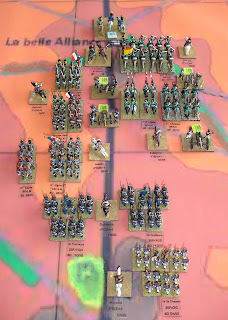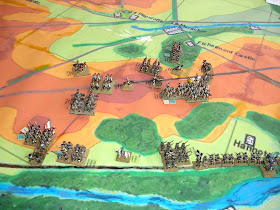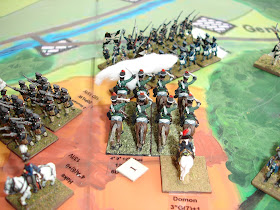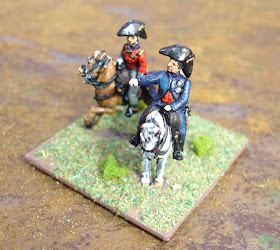The deployment of the French forces available for the scenario. Napoleon is there just to facilitate tracing command. The order of battle is straight form the Waterloo scenario I put together with the aid of Mark Adkin's The Waterloo Companion and some insight into the 4th Edition of Napoleon's Battles that facilitates small size units (or rather doesn't require amalgamations into minimum 16 infantry and 12 figure cavalry units).
14:00 and Lobau moves his corps to face the Prussians who have just arrived.
15:00 turn and both the 15th and 16th Prussian Brigades (division equivalents) are heading down the road to Plancenoit in march column.
The French are ready, with the cavalry of the 3rd and 5th Division on react.
15:00 The Prussians start to deploy out of march column as their artillery starts to arrive. The entry point for everything is Lasne. The woods, streams and roads are critical given their effect on the Prussian's options. Care needs to be taken to leave meaningful gaps (particularly noticeable when juggling between 16 and 20 figure infantry forming column and the latter finding that it can't get through a two inch gap).
The 107e Ligne have got to a wood to try and block the Prussians moving down the road while a brigade of the 19th Division has moved into the Fishermont wood with a similar aim.
The French cavalry is position to make the first of a series of devastating charges on the congested Prussians..
Julian encouraged me to attack with the 107e. Being a small unit they were quickly wiped out. However the remainder of the French 20th Division formed a good roadblock, particularly with cavalry support close by.
This was the disasterous move for the Prussians as in trying to deploy they had put their cavalry out of command.
The French cavalry are ready to take on the Prussian cavalry which is stuck in march column. The 20th Division has repelled the Prussians threatening Plancenoit.
17:30 turn and the Prussians have stalled.
At this point Julian had to leave, encouraging me to finish it solo.
At the end of the 18:00 turn the French cavalry are making some desperate charges to delay the Prussians.
The death ride of the 5th Cavalry division, eventually dispersed due to winners losses - lucky for the Prussians.
Lobau's corps starts to fall back.
By 19:00 the 20th Division that was blocking the road has been eliminated and the Prussians look like they have their act together to push on to Plancenoit.
Napoleon has dispatched the Young Guard (this happened in the 18:30 turn when the Prussians were with 1,200 yards of Plancenoit - more or less).
Blucher was working hard rounding up units.
The 3rd Cavalry, supported by a brigade from the 19th Division (the other one is still holding the Fischermont woods) make a coordinated attack to buy time for the Young Guard to deploy.
The attack achieved its aim, but the 3rd Cavalry Division has almost ceased to exist as a fighting force.
The Prussians come on.
The Young Guard hold Plancenoit supported by one brigade of the 20th Division (the other one is still fighting in the Fischermont wood)..
The Prussians are bearing down on the French, but time is running out (this is the end of the 19:30 turn)
20:00 and the Prussians, while in overwhelming numbers, have trouble bringing their weight to bear.
20:30 time is slipping away and still the Prussians are not ready to attack.
21:00 darkness is falling, one Prussian brigade is ready to go in.
The last turn and Blucher leads a regiment of Silesian landwher in a determined assault.
There he is, waving his pipe - doesn't he know subjecting his children to passive smoking is dangerous?
The Prussians get shot up going in, but use a Free Roll to change that. Then then use their second and last Free Roll to change an adverse close combat result to something more favourable.
The combat continues and this time the Prussians get a decisive result...
The French use a Free Roll and the result is a tie (the Prussians were on +4 and the French on +5)
A tie result with such high modifiers causes three casualties per side which routs them both... DRAW
In all the excitement I now see I failed to add in +1 for the French commander. The combat would have gone to a third round with both sides with one casualty.
Double whoops - that 5 9 die roll outcome would have been a 10 all tie and the Prussians would have routed at that stage. I should have attacked with two units.
The critical thing seems to be handling the Prussian initial deployment with perhaps less haste. Having Blucher and von Bulow is a significant advantage that the Prussians need to exploit.
The other thing to watch for is the terrain, particularly giving yourself enough room to deploy.























































